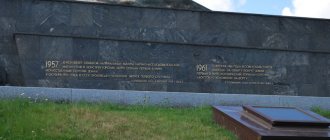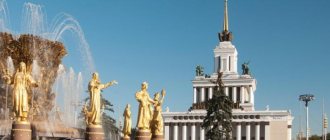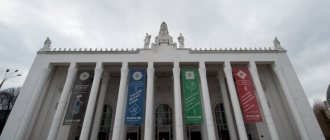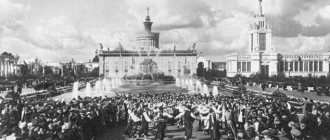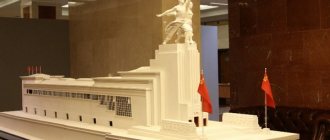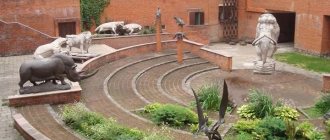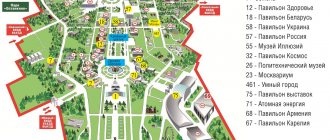Pavilion with history
It is impossible not to notice the Space Pavilion at VDNKh - it is a truly unique building and an architectural pride. Its history began on August 1, 1939, only then it was called “Mechanization” and looked different - it was a huge hangar. The pavilion acquired its modern appearance only in 1954. It was then that the famous dome appeared over the building. It rested on four powerful arches, and in the center they placed a star from the Trinity Tower of the Moscow Kremlin. In 1967, the pavilion received its current name – “Space”, and a full-size model of the Vostok launch vehicle on a 1:1 scale was installed in front of the building. The height of the model is 38 meters. The pavilion has gone through more than one renaming and change of exhibition, and in 2018 it appeared before VDNKh visitors in all its glory after a large-scale restoration.
What is "East"?
The rocket at VDNKh is a life-size model. It was created in the image and likeness of the “East”. The Vostok launch vehicle is truly a symbol of the space industry. It consisted of three stages, each of which used liquid fuel. It was with the help of Vostok that most Soviet and Russian spacecraft were lifted into orbit. Many artificial satellites of our planet would not be able to navigate outer space without the help of Vostok.
The rocket tried its first launch in 1958, although it was not successful, but a year later it took off from the cosmodrome very successfully. In 1961, the Vostok launch vehicle launched Yuri Gagarin's spacecraft into low-Earth orbit, thereby making him the first cosmonaut to travel into space.
Its total length, together with the fairing, is almost forty meters, just like the height of a sixteen-story building, and the launch weight reaches two hundred and ninety tons. By the way, the height of the rocket at VDNKh is the same as that of the prototype.
Gagarin at VDNH
In 1965, under the dome of the Space pavilion, which was then called Mechanical Engineering, a full-scale model of the Vostok spacecraft was exhibited for the first time. It was in such a ship that Yuri Gagarin made his legendary flight on April 12, 1961. The guest of honor at that exposition was Yuri Alekseevich himself along with his daughter. By the way, the first cosmonaut of the planet visited VDNKh several times.
Photo: mos.ru
Mechanization Square
The place where the rocket and the Space pavilion are located was once called Mekhanizatsiya Square, and instead of the Vostok launch vehicle, the only monument to Comrade Stalin was located at VDNKh in the early years. It was also of enormous size, but could not be compared with the height of the space machine. And soon a Yak-42 plane appeared on the square.
In 1989, Moscow was hit by a severe hurricane with heavy rain. According to eyewitnesses, the wind uprooted the thick trunks of spruce trees growing next to the rocket, but the twenty-five-ton model itself was not damaged.
At the helm is a real astronaut
The center is the only such museum in the country, which today is headed by a person who has repeatedly participated in space flights. Fedor Yurchikhin is the 98th cosmonaut in Russia and the 423rd in the world. From 2002 to 2021, he made five flights, three of which were as a ship commander and expedition commander. Their total duration was 672 days, 20 hours and 39 minutes. The astronaut has completed nine spacewalks with a total duration of 59 hours and 28 minutes.
Photo: mos.ru
Under the guise of disposal, the rocket at VDNKh was restored to its historical appearance. Photo report
In October 2010, at the Memorial Museum of Cosmonautics, as Vesti.Ru reported, employees were seriously concerned about the possible destruction of Yuri Gagarin's rocket backup at the All-Russian Exhibition Center (formerly VDNKh).
“After all, the decision was made to dismantle this rocket,” said cosmonaut Alexander Laveikin, deputy director of MMK, at the time.
A hollow inside model of the Vostok launch vehicle weighing 25 tons (the fueled rocket weighs 250 tons) was manufactured at TsSKB-Progress (Samara), installed at VDNKh and opened on September 20, 1969 together with the Space pavilion - as a symbol of the first space flight with human participation.
For the first time they started talking about the destruction of the Vostok missile at the All-Russian Exhibition Center two years ago. It was planned to build a kind of business center around the Space pavilion.
As part of this, according to a number of media reports, it was planned to scrap both the Vostok and the Tu-154 and Yak-42 standing nearby.
“They are in an acute state of emergency. Not just shabby, but rotten. Rusted through. The conclusion was: you can’t even take it out, you can only dispose of it on site,” said Irina Raber, prefect of the North-Eastern District of Moscow, in 2008.
“Officials wrote to us that it was of no value. There are no funds for its repair, and in order to receive funds, you need to obtain the status of a protected object, and since Moscow does not give this status, it turns out to be a vicious circle,” explained Sergei Mitrokhin, chairman of the Yabloko party, at the same time.
However, the result turned out differently.
“Like any engineering structure, a mock-up rocket requires maintenance, which is now being carried out by the All-Russian Exhibition Center. The last time work was carried out at the site was in 1985 and consisted of replacing the exhibit with an identical one. After 25 years, the object requires inspection from the point of view of its mechanical strength and safety, elimination of possible defects, as well as painting, taking into account the restoration of the historical appearance of the object,” said Alexander Egorov, Deputy General Director of JSC All-Russian Exhibition Center, in October 2010.
As part of the reconstruction, the supporting structures were strengthened and the paintwork was restored. The rocket was returned to its historical colors - it itself is white, the support stand is red, the railway installer platform is gray, and the platform wheelsets are black.
The bright red vertical inscription “Vostok” on the side of the rocket was rewritten.
In addition, it turned out, contrary to some reports, that the rocket is on the balance sheet of the All-Russian Exhibition Center itself, and not the Memorial Museum of Cosmonautics or Roscosmos.
By the way, it is interesting to note that before the “cult of personality” was exposed, a monument to Joseph Vissarionovich Stalin stood on the site of the rocket.
Photos from the sites Savok.name, dic.academic.ru and Alexey Shironin.
See also the list of all photo reports in the Cosmonautics section on Polit.ru by following the link.
AS
Layout of the legendary station
The unique and largest exhibit of the center is a full-scale model of the Mir orbital complex. Its weight is 30.9 tons (the original weighs more than 120 tons). The Mir station is a record holder of the 20th century; it was used for long-term expeditions and scientific experiments in flight conditions. Over the years of the station's existence, 104 cosmonauts from 12 countries visited it in orbit, 29 people made 70 spacewalks, and a huge number of records were set here. Now a copy of the legendary complex can boast of achievements: about a million visitors have visited the models of its modules “Kristall” and “Kvant-2”, located in the center.
Photo: mos.ru
Museum of Cosmonautics in Moscow
Right there, at VDNKh, just on the opposite side from the rocket, next to the VDNKh metro station and the Cosmos Hotel, there is the Museum of Cosmonautics, which I also went to that day.
In April 1981, the Memorial Museum of Cosmonautics was opened in the stylobate of the “Conquerors of Space” monument. In 2009 it was opened after reconstruction in 2006-2009.
The modern exhibition consists of the following halls:
- "Morning of the Space Age";
- "Space Age Creators";
- “Space house in orbit” (modern manned astronautics);
- “Research of the Moon and planets of the Solar System”;
- “Cosmonautics for humanity”;
- “International cooperation in space”;
- “International Space Park” (space states of the world, Russian rocket and space industry);
- "History and culture of the space age."
To understand what each part of the exhibition is about and where exactly in the museum it begins and ends, you need to either be an employee of the cosmonautics museum or go here with a guidebook. I’ll tell you and show you the museum the way I saw it.
So, according to my logic, I would divide it into the following zones:
Authentic spaceship
You can find not only real lunar soil, but also an equally real spacecraft - the descent module of the Soyuz TMA-10M manned transport spacecraft. It was he who brought the Olympic torch relay participants Oleg Kotov and Sergei Ryazansky to Earth. They joined the symbolic relay race, which took place in outer space for the first time. The composition of the torch allows it to burn in any conditions, even under water, but despite this, they did not light it during the flight. However, it was the torch that was behind the ISS that was used to light the fire in the bowl at the Fisht stadium in Sochi during the opening of the XXII Winter Olympic Games.
Photo: mos.ru
ISS in touch
On April 10, 2021, the first direct communication session with the International Space Station took place in the Cosmos pavilion. The conversation with pilot-cosmonauts and heroes of Russia Alexey Ovchinin and Oleg Kononenko lasted about half an hour. The cosmonauts congratulated the visitors on the upcoming Cosmonautics Day, and the daughter of the great designer Sergei Korolev, Natalya Korolev, on her birthday. Natalya Sergeevna was then invited to the center as an honorary guest.
Photo: mos.ru
The first artificial satellite of the Earth
In the fall of 1957, just a couple of weeks after the successful launch of the first artificial Earth satellite, guests of the exhibition were able to see its exact copy . The exhibit created a sensation: in the first three months, the Science pavilion, where it was exhibited, was visited by more than 3.5 million people. Muscovites and tourists were often shocked by the compact size of PS-1 (“The simplest satellite - 1”): the first viewers could not believe that a metal ball with a diameter of only 58 centimeters was able to circle the Earth and obtain unique data that gave impetus to all aerospace science.
By 1967, the model was moved to the Space pavilion. And more than two decades later, when shopping arcades opened in the pavilion, the famous ball with rays was lost . But a year ago, the satellite “returned” to VDNH: in 2021, a new full-size copy of the first Earth satellite was installed in the “Cosmos” pavilion.
VDNH satellite in orbit
To mark the 80th anniversary of the country's main exhibition, a satellite called VDNH-80 was launched into space. On July 5, 2021, it went into orbit as a secondary payload from the Vostochny Cosmodrome. The spacecraft is still in orbit and transmits space weather data.
On August 1, 2019, the VDNH-80 satellite transmitted an audio signal. He notified radio amateurs from all over the world about the anniversary of the exhibition. On the same day, a position as a telecom operator with VDNKh-80 appeared. Visitors can examine telemetry data from the satellite and follow its flight path.
Photo: mos.ru
Vostok launch vehicle
On July 8, 1967, in honor of the 50th anniversary of the Great October Socialist Revolution, a copy of the Vostok launch vehicle that delivered Gagarin into orbit was installed at VDNKh. The model was placed on Industry Square near the Space pavilion.
Vostok was created at the Samara Rocket and Space Center and repeats all the main parameters of the original launch vehicle: it weighs 4.7 tons and rises 38.4 meters, which is approximately equal to the height of a 16-story building . Today, like 50 years ago, the model serves as a kind of monument to the aerospace industry of the USSR and a reference point for those who are looking for.
Space scouts
Orbital manned stations of the Almaz series were designed for reconnaissance of the earth's surface from space. Two astronauts could work in orbit and take pictures. In you can see a full-scale example of one of these stations.
In 1978, work on the Almaz was stopped, but unmanned versions began to be created. At their core, the devices were heavy satellites. In addition to the camera, they were equipped with a locator called “Sword”. On July 25, 1987, an unmanned station was launched, which became known as Cosmos-1870, and on March 31, 1991, the Almaz-1 apparatus was launched. It carried out reconnaissance of the situation around the ship Mikhail Somov, trapped in the ice of Antarctica. Thanks to the photographs taken by the station, it became possible to organize a rescue operation.
Photo: mos.ru
ABOUT NOTHING... AND ABOUT EVERYTHING
- Section: History of the USSR
- Tags: Architecture, VDNH
- Views: 1827
- Subscribe to comments via RSS
We went for a walk around VDNH this weekend. I wanted to photograph the R-7 rocket, which stands in front of the Cosmos pavilion. After the barbaric destruction of the TU-154, and rumors about a similar fate of the R-7, I wanted to photograph this unique monument in detail. The missile turned out to be fine, but the Yak-42 was turned into some sort of scarecrow. It became sad. The weather also let us down, it was cloudy and windy. Plus, while photographing the rocket, I realized that I had made a mistake with the lens. I took the long-focus 70-200 mm, but I should have taken the standby 24-105 mm. And I also thought about Fish eye, which is not enough for shooting panoramas.
Despite the weekend and a fairly large number of people, there was no fun. Still, the weather brought a surprise, and it was very interesting to watch people who were clearly counting on a warmer day. The woman sat on the bench and clenched and unclenched her fingers. The girls were dressed in frivolous, almost summer, skirts, and moved around the territory with a fast gait. Several teenagers were literally trembling while standing on the stairs of the main pavilion “Friendship of Peoples”.
We reached the rocket. You're lucky - it's still standing, shining with its freshly painted sides (redecoration was carried out that year). On the body there is a proud inscription - East. At school we were told that it was this rocket that launched the Vostok spacecraft into space with Yuri Gagarin on board.
Much later, I learned that rockets burn up in the atmosphere and fall into the Kazakh steppes in a pile of debris. therefore, at VDNKh there simply cannot be a rocket that would be in space at all. But that doesn’t make history stop being history. This is precisely the R-7 missile, an intercontinental missile for delivering nuclear weapons to the United States. And if not for the space race, not for the task of being the first in space, perhaps rockets of this type would not have had to launch a person into space, and not a uranium warhead.
The R-7 rocket that stands at VDNKh, strictly speaking, is not a flight model. It was prepared specifically for exhibitions, and it was unlikely that it contained components that constituted a State secret of the USSR. But a place for it at VDNKh appeared long before the start of rocket production in general. It so happened that it replaced the monument to Stalin, which stood in this place before the historic 20th Congress of the CPSU.
But let's take things in order. VDNKh was organized in 1939, as usual, at the request of workers, in order to exchange advanced socialist experience between the fraternal Soviet republics. And at the most trump point, after the guests of the exhibition had walked through almost the entirety of it, they could observe the gigantic statue of J.V. Stalin. Behind it was the arch of the pavilion “Mechanization and Electrification of the USSR” - the most important areas of development of the USSR.
Interestingly, the monument was dismantled in 1952, during Stalin’s lifetime. Why did this happen? Perhaps because of Merkulov’s letter to architecture, where he wrote that the monument made of concrete was being destroyed, and it was impossible to stop this destruction. Is it because of Yuri Zhukov’s version in the book “Stalin: Secrets of Power”, where he writes that in the last 2 years of his life Stalin was removed from power? Today it is probably difficult to say.
From 1954 to 1963, the pavilion housed an exposition of civil engineering. In 1954, the arch was modified, an arch with a dome appeared, decorated with two sculptures - a tractor driver and a machine operator, which in the future will look very strange with the theme of astronautics.
Since 1963, it was decided to repurpose this pavilion for the exhibition of the most significant achievement of the Soviet Union - cosmonautics. The pavilion was renamed "Cosmos". The pavilion itself housed models of satellites - “Moon”, “Mars”, “Venus”, a model of the world’s first artificial Earth satellite. A visit to the pavilion was mandatory in the program of Moscow schoolchildren.
But the main exhibit was the R-7 rocket. She did not appear immediately. A full-size model was made, as I wrote above, for display at the Paris Air Show in Le Bourget in 1967. Here is a photograph showing the moment the rocket was installed on a transporter in France.
The rocket aroused great interest. Crowds of exhibition guests literally swirled around her.
After the rocket returned from the exhibition, it was decided to install it at VDNKh, near the Cosmos pavilion. In 1969, she took her place. Here is a photograph of VDNKh 1979 with a rocket installed, and the rocket in a horizontal position (it is unknown, only when).
The rocket remained in this form until 2010.
Next is our reality. After the destruction of the TU-154, rumors began to circulate about the imminent dismantling of the missile. The leadership of the All-Russian Exhibition Center denied this, but an initiative group was even formed to protect the rocket. Here is a poster for this group.
To dispel rumors and relieve tension, the VDNKh administration began repairing the rocket. The rocket was repainted, the inscriptions USSR and “Vostok” were updated. The transport platform was completely repainted in brick color. The rocket has found a second life. I really want to believe that it will last for a long time.
And the Space pavilion looks like this today. For comparison, here is a picture from 30 years ago.
On September 13, 2008, a TU-154 was barbarically destroyed at the All-Russian Exhibition Center, in front of a huge crowd of people. This caused a huge public and cultural outcry, thanks to which it was possible to save the second aircraft, which probably faced the same fate - the Yak-42. This aircraft model has firmly taken its place in civil aviation of the USSR and Russia, replacing the obsolete TU-134
The Yak-42 installed at VDNKh has serial number 01-02, that is, it is the second aircraft in the series. It was assembled in Saratov in 1978. Considering the date of assembly, it was most likely hastily prepared for the Le Bourget Air Show, which took place in June 1979.
He flew there on the route Zhukovsky - Warsaw - Le Bourget with exhibition number No. 349. Here's a photo of him at the air show. This is exactly the plane that stands at VDNKh today.
According to some reports, the first plane crashed near Lvov, during the flight to Le Bourget, and the Yakovlevites urgently prepared the second plane. Considering that the plane was the second in the series, it did not have to carry passengers, in September 1981 it was installed at VDNKh as a monument as part of the Aviation and Cosmonautics pavilion complex.
Although the public managed to protect the plane from destruction, it is not in very good condition. The edges of the wing are dented, there is no marker light on the right wing, and there is through corrosion in places. This is just what I noticed while I was photographing it.
But what was most upsetting was that the plane, which had a clear graphic livery of a USSR civil aviation aircraft, was turned into some kind of New Year tree, decorated with battle scenes before the May 9 holiday. Some infantry with Kalashnikov assault rifles and modern bayonets, a support tank in which I could only identify a German Panther, an abundance of St. George ribbons. For some reason, some government vehicle painted like Khokhloma appeared. How ashamed should he be? And most importantly, what does a civilian aircraft of the 80s have to do with military issues and the victory over fascism?
Below I took a summary photo to show how this aviation monument looked quite recently, and how it will most likely never look again. I don't expect him to get his previous coloring back. At best, they will repaint it to resemble Russian airlines. It’s a shame that the sabotage.ru studio left a link to itself on the tail of the plane. They are unlikely to be remembered with a kind word. The plane is intact, but the monument is destroyed.
What else was interesting? The fountains had not yet been turned on, although it seemed to me that they would start working in April. Therefore, it didn’t work out to film Ostankino with a rainbow in water dust. But I'll catch up.
We stopped on the way to the Belarus pavilion. We bought several chocolates there. One turned out to be very interesting and very tasty - with rowan filling.
A very unusual taste of highly sour filling and sweet chocolate. We took a couple more pictures before leaving. I even liked one. We managed to remove it so that all the bazaar and market paraphernalia of today's VDNKh were not visible.
It was already evening and it was getting quite cool. You need to go to the car through one of the side exits from the All-Russian Exhibition Center. Only ruffled and frozen blackbirds saw us off.
Share note
Mission Control Center
The pavilion's own Mission Control Center (MCC) is located in the under-dome space of the pavilion. Of course, it is inferior in scale and tasks to the main Russian Mission Control Center in Korolev, but here anyone can feel like an expert in the field of astronautics.
Three huge screens display in real time the position of the ISS in orbit and other important information necessary for mission control. But the main thing is that here, sitting at the monitor, everyone can design a spacecraft, independently build an orbit for it and see how it will move along it. And for those who want to step beyond near-Earth space, there are more difficult tasks: putting satellites into the orbit of the Moon or Titan and sending an interplanetary station to Mars.
Photo: mos.ru
Space show at VDNKh: two skating rinks “Tsvetnik” and “Raketa” opened
The “City of Winter” was built at VDNKh. Photo: VDNH press service
The new winter season at VDNKh is radically different from previous ones. The organizers decided to go for a walk and built a whole “Winter City”. You could see all the entertainment at once on November 30th.
—Where is the biggest skating rink? - Muscovites asked.
“This year, the “Friendship of Peoples” and “Stone Flower” fountains were sent for restoration, but two skating rinks were flooded: “Flower Garden” and “Rocket,” said the organizers. “They also opened the North tubing hill, a curling pavilion and a place for playing Yukigassen snowballs.
The most amazing thing was the Raketa skating rink. The ice rink on Industry Square at VDNKh has never been flooded. The skating rink is round, you ride and admire the model of the Vostok launch vehicle. Bright “planets” appeared near her, and the entire skating rink was strewn with round balls, which created a truly cosmic atmosphere.
People in spacesuits and girls in neon suits appeared at the skating rink. Photo: VDNH press service
People in spacesuits and girls in neon suits appeared at the skating rink. And the show began - the Australian theater Strange Fruit showed luminous spheres, and acrobats from a height of seven meters made such turns that many did not have enough words to describe the delight. The artists spoke about the miracle of the birth of the Universe and the beauty of this world.
The same show was shown at the Tsvetnik skating rink. There were also quite a lot of decorations in the form of spheres. But the atmosphere was more restrained, one might say, family-like. So, if you want to go skating with the whole family, teach your child how to do the “Christmas tree” or “flashlight”, then it’s better to come to the “Tsvetnik” skating rink. But young people will appreciate the drive and speed at the Raketa skating rink - fashionable discos will be held here.
Space show at VDNH
“We have drawn up a very convenient schedule: when there is a technical break at one skating rink for snow removal and cleaning the ice surface, the second skating rink will be open. Thus, Muscovites will be able to go ice skating at VDNKh at any time,” says Yulia Davydova, a representative of the VDNKh directorate.
This year, the “Friendship of Peoples” and “Stone Flower” fountains were sent for restoration, but two skating rinks were flooded. Photo: VDNH press service
The severe frost on the opening day did not allow the maximum number of people to gather at the skating rinks, but as soon as the weather becomes milder, 2,400 people will be able to go to the “Raketa” ice rink, and 1,200 people to the “Tsvetnik” skating rink. But on the opening day, the sky was colored with beautiful fireworks, which were visible from all the skating rinks at VDNKh. After which the festive dancing continued until late at night, Muscovites were entertained by the world-famous Swanky Tunes DJs.
IMPORTANT
All activities will be available until March 10, 2021. You can find prices and opening hours here.
